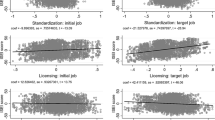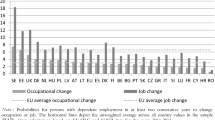Abstract
This paper applies Lazear’s skill-weights approach (2009) to analyze the specificity of skill combinations of various occupations and its effects on occupational mobility and wages. The results show that the more specific an occupation, the smaller the probability of an occupational change. We also identify clusters of occupations characterized by similar skill combinations and find that employees in specific occupations have a comparatively higher probability of changing occupations within a skill cluster than between skill clusters. Moreover, occupational mobility within a skill cluster results in wage gains, while between clusters it results in wage losses. Therefore, the acquired skill combination and the resulting skill cluster, rather than the occupation per se, crucially determines mobility. Thus, for educational policies, it is more important to study whether a skill cluster is sustainable than an occupation.
Similar content being viewed by others
References
Aiken, L. S. & West, S. G. (1991). Multiple regression: Testing and interpreting interactions. Newbury Park: SAGE
Aldenderfer, M. S. & Blashfield, R. K. (1984). Cluster analysis. SAGE University papers on quantitative applications in the social sciences, No. 07-044. Beverly Hills: SAGE
Autor, D. H.; Levy, F. & Murnane, R. J. (2003). The skill content of recent technological change: An empirical exploration. Quarterly Journal of Economics, 118(4), 1279–1333
Autor, D. H.; Katz, L. F. & Kearney, M. S. (2006). The polarization of the U.S. labor market. The American Economic Review, 96(2), 189–194
Autor, D. & Dorn, D. (2009). This job is «getting old»: Measuring changes in job opportunities using occupational age structure. American Economic Review, 99(2), 45–51
Borghans, L. & Golsteyn, B. H. H. (2007). Skill transferability, regret and mobility. Applied Economics, 39(13), 1663–1677
Bortz, J. (1989). Statistik für Sozialwissenschaftler. Berlin/Heidelberg/New York: Springer
Carnoy, M. (2004). Education for all and the quality of education: a reanalysis. Background paper prepared for the Education for all global monitoring report 2005, The Quality Imperative
Clark, D. & Fahr, R. (2001). The promise of workplace training for non-college-bound youth: Theory and evidence from German apprenticeship. IZA Discussion Paper, No. 378. Bonn: IZA
Doeringer, P. B. & Piore, M. J. (1971). Internal labor markets and manpower analysis. Lexington, Mass.: Heath
Dustmann, C.; Ludsteck, J. & Schönberg, U. (2009). Revisiting the German wage structure. The Quarterly Journal of Economics, 124, 843–881
Eyraud, F.; Marsden, D. & Silvestre, J. (1990). Occupational and internal labour markets in Britain and France. International Labour Review, 129(4), 501
Fitzenberger, B. & Spitz, A. (2004). Die Anatomie des Berufswechsels: eine empirische Bestandsaufnahme auf Basis der BIBB/IAB-Daten 1998/1999. ZEW Discussion Paper No. 04-05. Mannheim: Zentrum für Europäische Wirtschaftsforschung
Geel, R.; Mure, J. & Backes-Gellner, U. (forthcoming). Specificity of occupational training and occupational mobility: An empirical study based on Lazear’s skill-weights approach. Education Economics
Geel, R.; Mure, J. & Backes-Gellner, U. (2009). Berufliche Bildung und Mobilität: Erklärungen mit Hilfe des Skill-weights Approach. Empirische Pädagaogik, 23, 479–498
Goeggel, K. & Zwick, T. (2009). Good occupation — Bad occupation? The quality of apprenticeship training. ZEW Discussion Paper No. 09-024. Mannheim: Zentrum für Europäische Wirtschaftsforschung
Goos, M. & Manning, A. (2007). Lousy and lovely jobs: the rising polarization of work in Britain. The Review of Economics and Statistics, 89(1), 118–133
Heckman, J. J. (1994). Is job training oversold? The Public Interest, 115, 91–115
Hotz-Hart, B. (2008). Erfolgskonzept «duale Berufsbildung» im Wandel, In: T. Bauder & F. Osterwalder (Eds.): 75 Jahre eidgenössisches Berufsbildungsgesetz. Politische, pädagogische, ökonomische Perspektiven. Bern: hep
Jaccard, J.; Wan, C. K. & Turrisi, R. (1990). The detection and interpretation of interaction effects between continuous variables in multiple regression. Multivariate Behavioral Research, 25(4), 467–478
Kambourov, G. & Manovskii, I. (2008). Rising occupational and industry mobility in the United States: 1968–97. International Economic Review, 49(1), 41–79
Kambourov, G. & Manovskii, I. (2009). Occupational specificity of human capital. International Economic Review, 50(1), 63–115
Ketchen, D. J. & Shook, C. L. (1996). The application of cluster analysis in strategic management research: An analysis and critique. Strategic Management Journal, 17(6), 441–458
Krueger, D & Kumar, K. B. (2004). Skill-specific rather than general education: A reason for US-Europe growth differences? Journal of Economic Growth, 9(2), 167–207
Lazear, E. P. (2009). Firm-specific human capital: A skill-weights approach. Journal of Political Economy, 117(5), 914–939
Leontardi, M. R. (1998). Segmented labour markets: Theory and evidence. Journal of Economic Surveys, 12(1), 63–101
Mardia, K. V.; Kent, J. T. & Bibby, J. M. (1979). Multivariate analysis. London: Academic Press.
Marsden, D. (1986). The end of economic man? custom and competition in labour markets. Brighton: Wheatsheaf Books
Mincer, J. (1974). Schooling, experience, and earnings. New York: National Bureau of Economic Research
Osberg, L.; Apostle, R. & Clairmont, D. (1987). Segmented labour markets and the estimation of wage functions. Applied Economics, 19(12), 1603–1624
Poletaev, M. & Robinson, C. (2008). Human capital specificity: Evidence from the dictionary of occupational titles and displaced worker surveys, 1984–2000. Journal of Labor Economics, 26(3), 387–420
Punj, G., Stewart, D. W. (1983). Cluster analysis in marketing research: Review and suggestions for application. Journal of Marketing Research, 20(2), 134–148
Shaw, K. L. (1987). Occupational change, employer change, and the transferability of skills. Southern Economic Journal, 53(3), 702–719
Spitz-Oener, A. (2008). The returns to pencil use revisited. Industrial and Labor Relations Review, 61(4), 502–517
Wagschal, U. (1999). Statistik für Politikwissenschaftler. München/Wien: Oldenbourg
Ward, J. H. (1963). Hierarchical grouping to optimize an objective function. Journal of the American Statistical Association, 58(301), 236–244
Winkelmann, R. (2006). Qualifikationsspezifische Beschäftigungsperspektiven und berufliche Flexibilität, In: A. Frick & A. Wirz (Eds.) Berufsbildungsökonomie: Stand und offene Fragen. Bern: hep
Wooldrige, J. (2009). Introductory econometrics: A modern approach. South-Western Cengage Learning
Author information
Authors and Affiliations
Corresponding author
Additional information
This research is partly funded by the Swiss Federal Office for Professional Education and Technology through its Leading House on Economics of Education, Firm Behaviour and Training Policies. We thank the participants at the SASE in Paris, the TASKS-workshop in Nuremberg, the research seminars at the University of Zurich, and particularly Ed Lazear for helpful comments and suggestions. The data used in this paper from the «BIBB/BAuA Employment Survey» were collected by the German Federal Institute for Vocational Education and Training (Bundesinstitut für Berufsbildung, BIBB) and the Federal Institute for Occupational Safety and Health (Bundesanstalt für Arbeitsschutz und Arbeitsmedizin, BAuA). The producers of the data do not bear any responsibility for the analysis and interpretation of the data in this paper.
Rights and permissions
About this article
Cite this article
Geel, R., Backes-Gellner, U. Occupational mobility within and between skill clusters: an empirical analysis based on the skill-weights approach. Empirical Res Voc Ed Train 3, 21–38 (2011). https://doi.org/10.1007/BF03546496
Published:
Issue Date:
DOI: https://doi.org/10.1007/BF03546496




